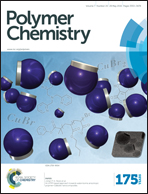RAFT synthesis of triply responsive poly[N-[2-(dialkylamino)ethyl]acrylamide]s and their N-substitute determined response†
Abstract
The thermo- and pH/CO2-responsive poly[N-[2-(dialkylamino)ethyl]acrylamide]s containing a polyacrylamide backbone but different N-substitutes of dialkylamine were synthesized and their solution properties were comparatively checked. A controllable RAFT synthesis of poly[N-[2-(dialkylamino)ethyl]acrylamide]s was achieved when a typical trithiocarbonate containing an easily cleavable R group was employed. The RAFT polymerization rate decreases with the increasing C-number in the N-substitutes. The thermo- and pH/CO2-responsive property of poly[N-[2-(dialkylamino)ethyl]acrylamide]s is firmly correlative to the N-substitutes. With the C-number in the R-substitute increasing, the solution properties of poly(N-[2-(dialkylamino)ethyl]acrylamide)s undergo a soluble-to-thermoresponsive-to-insoluble evolution, and the critical pH of poly[N-[2-(dialkylamino)ethyl]acrylamide]s gradually decreases. The dialkylamine moieties in the poly[N-[2-(dialkylamino)ethyl]acrylamide]s lead to a characteristic CO2-response during CO2/N2 bubbling. The present study reveals the structure-dependent solution properties of the thermo- and pH/CO2-responsive poly[N-[2-(dialkylamino)ethyl]acrylamide]s, and these multistimuli-responsive polymers are believed to be very useful due to the controllable RAFT synthesis and tunable solution properties.
![Graphical abstract: RAFT synthesis of triply responsive poly[N-[2-(dialkylamino)ethyl]acrylamide]s and their N-substitute determined response](/en/Image/Get?imageInfo.ImageType=GA&imageInfo.ImageIdentifier.ManuscriptID=C6PY00526H&imageInfo.ImageIdentifier.Year=2016)

 Please wait while we load your content...
Please wait while we load your content...